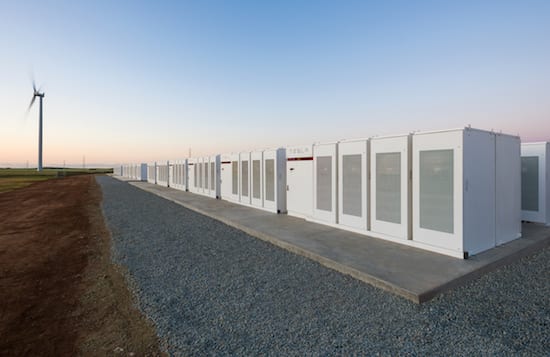The performance and economics of the Tesla big battery – otherwise known as the Hornsdale Power Reserve – continue to fascinate.
It is the first battery of its scale to be connected to Australia’s main grid, it’s the biggest lithium-ion battery installation in the world, and it is the pathfinder for dozens of other large-scale battery projects that will follow, including many under construction.
Further insight into the performance of the Tesla big battery – owned and operated by the privately held (but possibly soon to be floated) French renewable energy developer Neoen – have emerged in a new presentation by the Australian Energy Market Operator.
We’ve already had various assessments from private analysts, and AEMO, on the battery’s speed, accuracy and versatility, the impact of the battery in slashing peak prices in the FCAS market (frequency control and ancillary services), its share of that market, and the price reductions it has delivered to consumers.
But how much money did the Tesla big battery actually make for its owners?
It’s an important question for the battery storage industry, and the wind and solar industries, particularly as the market, indeed the need for time shifting storage emerges in markets such as Queensland, where middle of the day whole-sale prices are already falling below zero.
According to an AEMO presentation made at a Monash University forum last week, and not included in AEMO’s previous documents, the Tesla big battery earned a “gross margin” from wholesale market trading of around $2.5 million in the three months from January 1 to March 31.

It is important to note that these are AEMO estimates, and not official data from Hornsdale, nor its owner. It is not known what the folk at Neoen make of it, but it’s reasonable to assume that it is “in the ballpark.”
The biggest contributor came from energy arbitrage – buying at low prices and selling at high prices. AEMO estimates that half of this $2.3 million of revenue was generated across three days in January and February, when prices surged to or near the market cap.
It also earned money from FCAS regulation and contingency markets, and according to AEMO was actin e in FCAS markets 99.5 per cent of the time.
Between the Tesla big battery and demand response offered by EnerNOC, they captured 20 per cent of the country’s FCAS market and helped lower prices by around 57 per cent.
AEMO has also recognised – when the Tesla big battery has intervened after the sudden trip of a major coal unit – that the battery responded faster and more accurately than conventional plant.
It admits that this has caused it to rethink some of the management of the grid, and whether Tesla and other batteries should get paid for bringing that super fast response capability (they currently don’t).
The wholesale margin of $2.5 million for the quarter may not seem much for a battery, but it is important to remember that this only relates to the 30MW/90MWh component playing in the wholesale market.
The rest of the battery is reserved for as yet untapped emergency back-up services for the local grid, under an arrangement with the South Australia government that has not been disclosed, but could be as much as $10 million a year.
Previous reports from AEMO have given other insights into the Tesla big battery, including its pattern of charging and discharging (see graph above), and the difference between its average purchase of electricity and sale.
It should be noted however that this figure above – the $91 gap between buying electricity and selling it – is distorted by the extreme variation of prices in those events in January and February. The normal difference, casually observed from data on its website, suggests a range of around $30-$40/MWh.
We may have to wait for the Neoen prospectus to find out more.
Meanwhile, more Tesla Powerpack batteries are being installed at a 25MW/50MWh installation at the Ganawarra solar farm in Victoria, while South Australia’s second big battery – a 30MW/8MWh installation on the Yorke Peninsula, has just begun charging as part of its commissioning phase.












